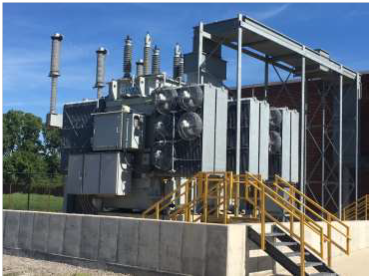
NEW 4 YEARS AGO-NEVER CONNECTED; STILL SITTING IN WWTP BACKYARD; SPENT $30 MILLION OF BORROWED MONEY
The new 3rd 120/13.8 kV Transformer installed and owned by the Great LakesWater Authority waiting for the 3rd Primary Electric Feed Line to be installed and energized.
DWSD stopped work on WWTP 3rd Feeder power project 4 years ago
Power outage of a few hours could be catastrophic in Delray, Springwells, Mexicantown; more than one week could fill region with untreated sewage
Poor communities will be targeted
Another Flint in the making?
By a Neighbor of the Wastewater Treatment Plant at 9300 W. Jefferson
August 16, 2017
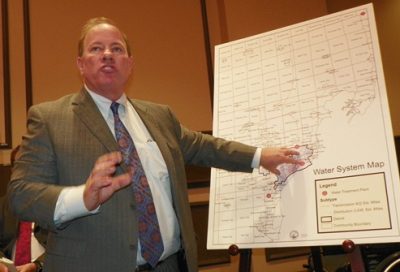
Detroit Mayor Mike Duggan, hands on Detroit, shows how rest of 6-county DWSD region will be taken over by Great Lakes Water Authority, during bankruptcy proceedings Sept. 9, 2014
Don’t be too harsh on farmers causing algae blooms. Don’t overlook the impact of human waste.
To say, “We need a stronger mix of regulatory programs and better enforcement” is no understatement.
Read below of the shameful behavior of the Detroit Water and Sewerage Department (DWSD) and the newly formed Great Lakes Water Authority (GLWA), operators of the Detroit Waste Water Treatment Plant (WWTP).
Lake Erie and Toledo are directly down the Detroit River from the Detroit Waste Water Treatment Plant.
Currently, the Wastewater Treatment Plant services the needs of 35 percent of Michigan’s population contained within Detroit and 76 other communities in an area of more than 946 square miles.
The WWTP treats approximately 650 million gallons per day (MGD) of wastewater on average. In wet weather, the Plant processes 1700 MGD.
[VOD: Since the takeover of the Detroit Water and Sewerage Department (DWSD) by the Great Lakes Water Authority (GLWA) in 2014, the GLWA operates, governs contracts, and receives revenue from all treatment and other facilities formerly operated by the DWSD.]
Detroit and the GLWA have, for all practical purposes, ignored their obligation to add reliable Primary Electrical Power to the WWTP. Practical purposes means that today there is no additional operational Primary Power contrary to DWSD publications. Thirty million borrowed dollars have been spent to accomplish this unfulfilled commitment to add Power. The Project was arbitrarily and unilaterally stopped by DWSD four years ago when only 10% of the project remained to be completed.
The chronology below shows a deliberate procrastination with damaging consequences downriver. The consequences of a sewage back up for a few hours will be catastrophic in Delray, Springwells, and Mexicantown. A power outage for a week or more could fill the streets of Detroit, Ferndale and beyond with raw sewage.
The Primary Power Project (AKA 3rd Feeder) was fully funded. Money was not an issue. The new power could have been up and running four years ago. This risk has been undisclosed and unknown to the general Public. Similar to the Flint water situation, a catastrophe can be easily avoided. This Electrical threat could be eliminated in 90 days if politicians are pushed by the electorate, especially in this election cycle.
It is well known that those with little cash and little or no insurance will be in the most dire and desperate circumstances from a sewage backup. Those people are primarily the growing ranks of minorities, the poor, the elderly and children. These people will probably have no choice but to abandon their homes. Why, they ask, put us at such peril? The City of Detroit has offered Delray citizens free alternate housing to move out of Delray. Could it be that a few have agreed to implement a new form of Urban Renewal? This course of inaction could vacate entire neighborhoods. Is this the creation of a new city plan?
“We need a stronger mix of regulatory programs and better enforcement as well as the actual use of the terms transparency and accountability.”
PRIMARY POWER AT WWTP DOWN FOR A COUPLE MONTHS – July 2017
Video above: DTE Plymouth substation explosion Aug. 17 left thousands without power. If this at happened at the Maxwell substation, the Wastewater Treatment Plant would be out of business, says story author.
The single source of electrical power to WWTP, a DTE substation named Maxwell, had a big failure in July.
Contrary to claims by GLWA regarding single sourcing, the statement that a single substation with two lines is redundant and complies with Michigan Department of Environmental Quality regulations is not totally accurate.
One line went down with time to take remedial action – the questionable second line was fired up.
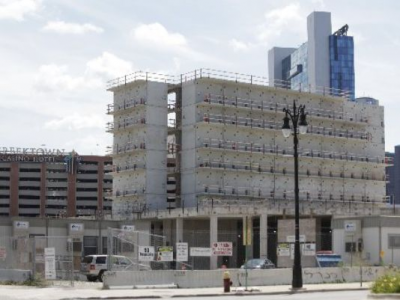
Cost of generators is same as cost to carry unfinished Wayne County Jail–$1M a month
There is no reliable backup for the second line and the 3rd Feeder Project was cancelled.
Consequently, Temporary Backup power was brought in via twenty 40 foot trailers with portable generators – The Plant could not rely on the existing on site generators as the Operators previously claimed.
The cost for the generators is approximately $1 Million per month (the same as the cost to carry the defunct County Jail – Peter Paul and Mary could sing “ Where has all the money gone, long time passing”)
The trailers have been on site for a couple months. Obviously, not a small repair.
If the outage was caused by an instantaneous event, such as lightning, both Maxwell lines may have gone down. They are only 130 feet apart.
It took a great deal of time in good weather and without a real instantaneous crisis mode, without competition from other facilities for the same equipment, to locate nearly two dozen very large generators, mobilize, install, lay cable and switches, connect to existing hard wire facility, and avoid fire and injury. What if this happened by lightning in foul stormy weather? The Plant would be unsuccessfully trying to process 1700 million gallons per day. The backup on site generators cannot handle the load.
Of course the GLWA response will be tempered with the usual semantic trickery – Delay – Deny – Defend- Circumvent, then bring in the Ladies of ill repute, Misdirection- Misleading and Misinformation.
Fact – No portable generators would be required if DWSD completed the 3rd Feeder Project.
Upon close inspection it is evident that there have been a series of efforts over 20 years and by a multitude of “DWSD” entities to configure, argue, obfuscate and manipulate their way to an outcome whereby they would be permitted to rely on the supposed stable and omnipresent DTE Electric facilities and services that make ubiquitous, allegedly “reliable” electric utility service available to the public. Simultaneously it was claimed in GLWA Public Meetings in September 2016 that the WWTP is vulnerable to power failure and there is no true redundant power, and that if Maxwell goes down, the Plant will have no off site power. See http://www.glwater.org/wp-content/uploads/2016/01/AppendixB-Sewer-20170518.pdf.
1999
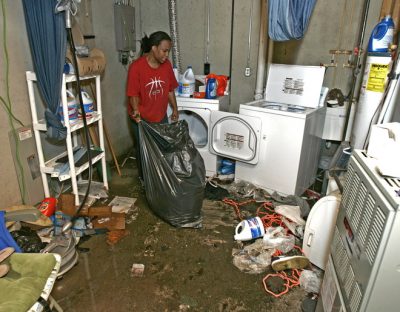
Typical basement sewage backup.
Nov. 21, 1999: Kathleen Leavey, Deputy Director Detroit Water & Sewerage Department announced today, “The loss of our ability to treat and distribute potable water because of a power outage could have grave effects on the system. As for water, an interruption in pumping would create air pockets in the pipes that could permit pipeline contamination from groundwater. Sewage could back up into basements and surface waters. The consequences to the environment, our health and the machinery in our plants could be devastating.”
2009
DWSD statement via Customer Outreach Portal: “upgrading an aging electrical system or backup power to this type of facility would have the highest priority due to the consequences of failure.”
2011
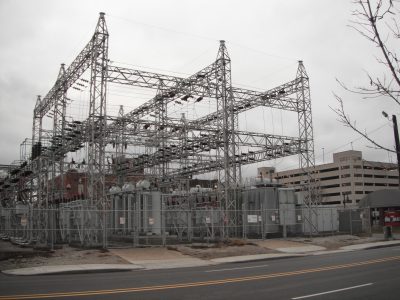
Typical electrical substation.
Power failure on September 8, 2011 resulted in NPDES permit violation VN- 005096 by MDEQ. Service originated from a single electrical substation. At the time of power failure, DTE’s Maxwell A and Maxwell B substations were tied together, sharing the load for the WWTP.
The Edison Maxwell Electrical Substation, a single substation, remains in 2017 as the only source of Primary Power to the WWTP.
“In 2011, the worst year for algae on Lake Erie, there were 45 billion gallons of sewage overflows into the Detroit River to Toledo from the Detroit Wastewater Treatment Plant,” wrote Jim Lynch of the Detroit News. An extended Primary Power outage would have pushed this discharge backwards to homes and businesses.
2014

DWSD has not figured out how to get from A to B.
DWSD stopped work on new Primary Electric Power Supply titled the “3rd Feeder,” (Contracts 1449 and 783), approximately 90% complete. The completed work cost $30 million borrowed funds, which included actual planning and building of a new transformer, a new building and related switches and ducts to accomplish this ‘mandated’ Electric Service. Despite this work scheduled in the Capital Improvement Plan, for nearly 20 years, DWSD has not figured out how to get from A to B.
The completed 90% of the project is similar to building a “Bridge to Nowhere.” DWSD partially built a necessary facility which does not meet the project objective – additional Primary Power to the WWTP. Required to complete the last 10 percent of the project is the connection of 3800 lineal feet of Primary Service Cable, on a relatively straight line, from the Edison Regional Power Grid, Point ‘A’, to the Treatment Plant, Point ‘B’. That is the final 10% of the Project – “A to B”.
2014
Michigan Department of Environmental Quality Director Dan Wyant introduced a slate of initiatives aimed at reducing the amount of phosphorus Michigan contributes to Lake Erie. He said, “While the fertilizer and animal waste that runs off from large-scale farming operations correctly gets its share of the attention, human waste — mostly in the form of combined sewer overflows — is a major contributor to the algae problem.”
9/19/14
Karen Rae Boase, MDEQ Enforcement Specialist wrote this email:
The third transformer has been installed on site and the electrical switchgear for the new transformer was installed and will be tested next week. Before the transformer can be brought on-line, DTE will have to provide the electrical feed line to the WWTP.
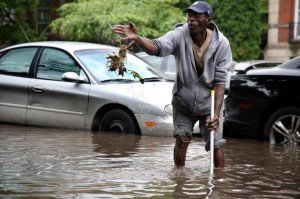
Larry Young of Highland Park tries to clean out sewer on his street in Aug. 2014 during massive floods actually caused by shutdown of sewage pumps at Detroit Wastewater Treatment Plant.
“Michigan State officials say billions of gallons of raw and partially treated sewage were dumped in Detroit Area Rivers and streams after flooding from heavy rains earlier this month,” MDEQ spokeswoman Laura Verona told The Detroit News in Aug. 2017. She said that about 46 percent of the nearly 10 billion gallons of sewage released Aug. 11,2014 by water treatment facilities was raw, diluted or partially treated sewage. The 4.5 billion gallons of sewage would be the equivalent of submerging Detroit’s Belle Isle in about 14 feet of water”.
“Normally, the Detroit River looks blue,” said Bob Burns, a self-proclaimed Detroit river keeper, on Wednesday. “Now it looks brown because of the runoff and the sewage discharges.”
2016 September
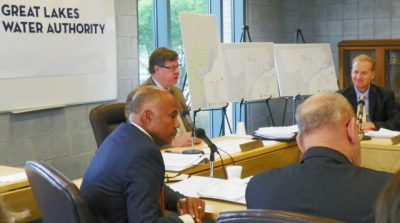
GLWA meeting June 12, 2015: (l to r) co-chair Gary Brown of Detroit, chair Robert Daddow of Oakland County, Board member Brian Baker of Macomb County, with maps showing areas covered by GLWA.
THE GREAT LAKES WATER AUTHORITY (GLWA) LEGAL COMMITTEE on Wednesday, September 14, 2016 at 11:30 am said,“this urgent 3rd power supply line to the WWTP needs to be installed at the earliest. The 3rd feeder from a different utility sub-station is required and this project will make WWTP’s primary electrical power supply reliable and redundant.” Presently there is no true redundant primary electrical service feed line to the WWTP.”
GLWA, which took over operation of the WWTP and every other facility that used to be run by DWSD in 2014, has ignored its own directive.
2017
No change since 2014.
3rd Primary Electric Feed Line needs to be installed and energized. Status Quo after nearly 20 years, the 2016 GLWA statement holds, “There is no true redundant power.”
The Detroit News reported that The Michigan Department of Health and Human Services (DHHS) said there have been 107 laboratory-confirmed cases of preventable liver disease in Detroit and Wayne… more than eight-times the number reported during the same time period last year. Two of those people died. The disease can be spread through contact with objects, food or water contaminated by feces.
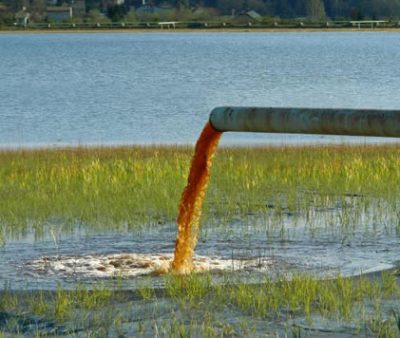
Water contaminated by feces.
Health officials say the two people both came in contact with raw sewage that backed up into a basement. Some say that given the repetitive and calculated actions of the DWSD, the inordinate time involved (20 years) the millions of dollars (over 30 Million) spent and the enormous risk (power failure) that continues to exist contrary to published requirements and project schedules provided by DWSD, may constitute a technical or non-monetary default of financing. By the same token, since the consequence of a power failure has been known to DWSD and the means of remediation have been under the care, caution and control of the DWSD, and with budget money available, and the DWSD intentional cancellation of the final solution segment over three years ago, Insurance Providers may consider claims from a power failure as a ‘set up ‘and therefore are uninsured.
The cost of the last 10% project completion does not amount to a rounding error compared to the cost of sewage cleanup.
DTE Reports on Power Interruption
Reliability Performance and Power Quality Resolution Process DTE Electric Report for 2016
Causes of Forced Interruptions – Calendar Year 2016
Forced Interruptions by Cause / Percent of Customers Interrupted
Conditions Trees Equipment All Other
Catastrophic Storms 74.3% 8.7% 17.0%
Small Storms 56.1% 24.5% 19.4%
Non-Storm 37.0% 34.3% 28.7%
Reliability Performance and Power Quality Resolution Process DTE Electric Report for 2015
1710 2/21 – 1622 Navarre-River Rouge PP Interruption Line Equipment – Interference – Ice
1711 2/21 – 1622 Navarre-River Rouge PP Voltage Sag Line Equipment – Interference – Ice
1712 2/21 – 1622 Navarre-River Rouge PP Voltage Sag Line Equipment – Interference – Ice
This information may help present a more balanced perspective of the Algae / Sewage Backup Problem in the future.
Exhibits Below contain confirmation for the observations discussed above.
https://outreach.glwater.org/LinkClick.aspx?fileticket=6yVPiLzjJ_g%3d&tabid=39 – see CIP 366 & 1402
http://voiceofdetroit.net/wp-content/uploads/GLWA-CEO-Report-February-2017.pdf.) Enter Search – WWTP then read “Do not drink the water’ & “Near catastrophic Failure”
http://archive.dwsd.org/downloads_n/about_dwsd/bowc/presentations/bowc_Sewer_FY_2016_Preliminary_CIP_2015-01-14.pdf – See Item # 10 pg 19 of 49 & Item #9 pg.30 of 40
http://www.glwater.org/wp-content/uploads/2016/09/091416-LEGAL-CommitteePacket-REVISED.pdf Legal Committee / See New Business # 7 A Resolution of Necessity then scroll to pg. 60 thru 150
http://www.glwater.org/wp-content/uploads/2015/01/September-28-2016-Board-Packet.pdf Board /See New Business Item 8A Resolution of Necessity – then scroll down past pg 2 of Coffee Exhibit to “Motion”.
Related from Detroit Free Press
http://www.freep.com/story/news/local/michigan/detroit/2017/06/19/detroit-sewage-plant-risk-power-failure/391801001/
Related VOD stories:




